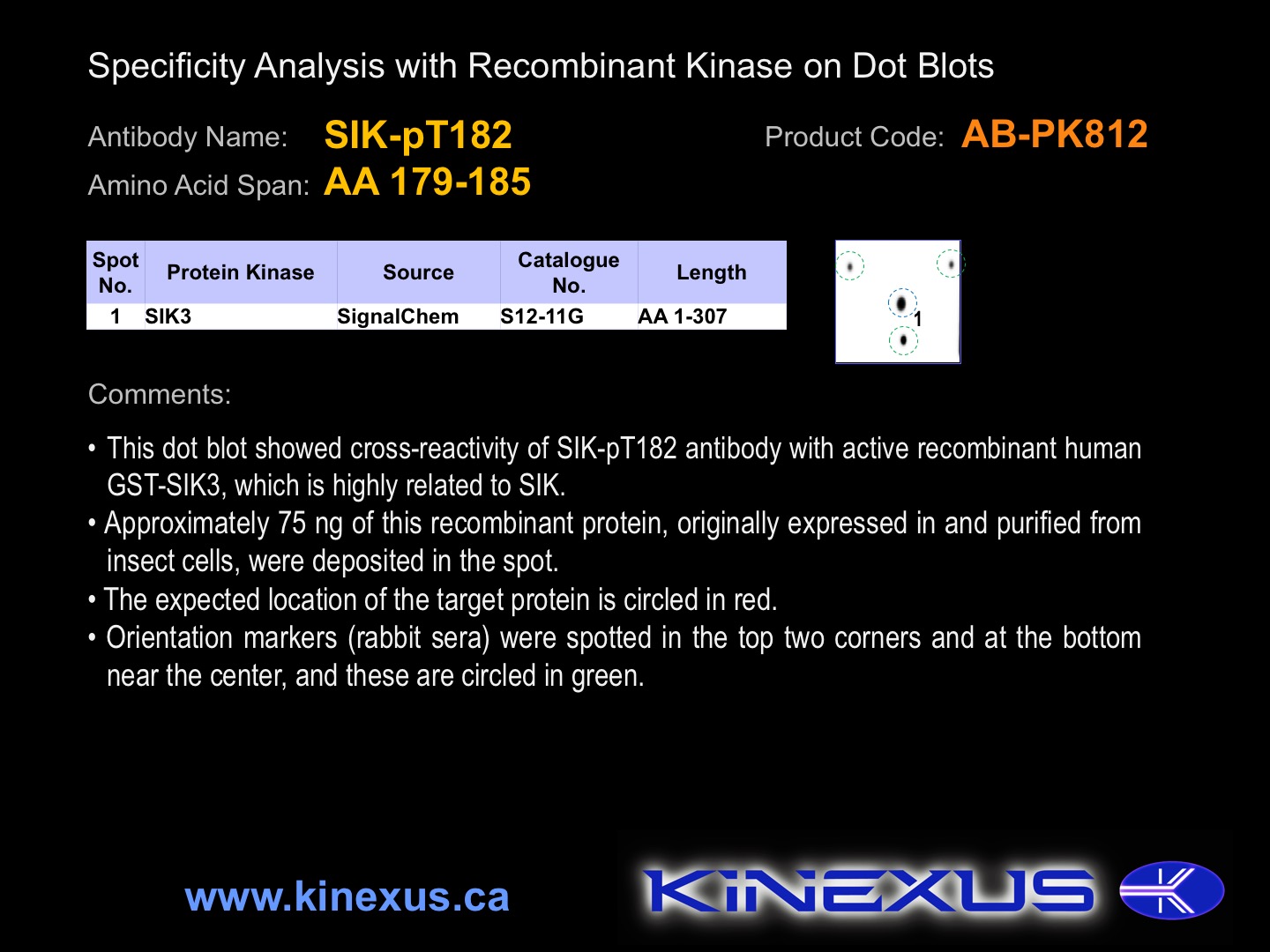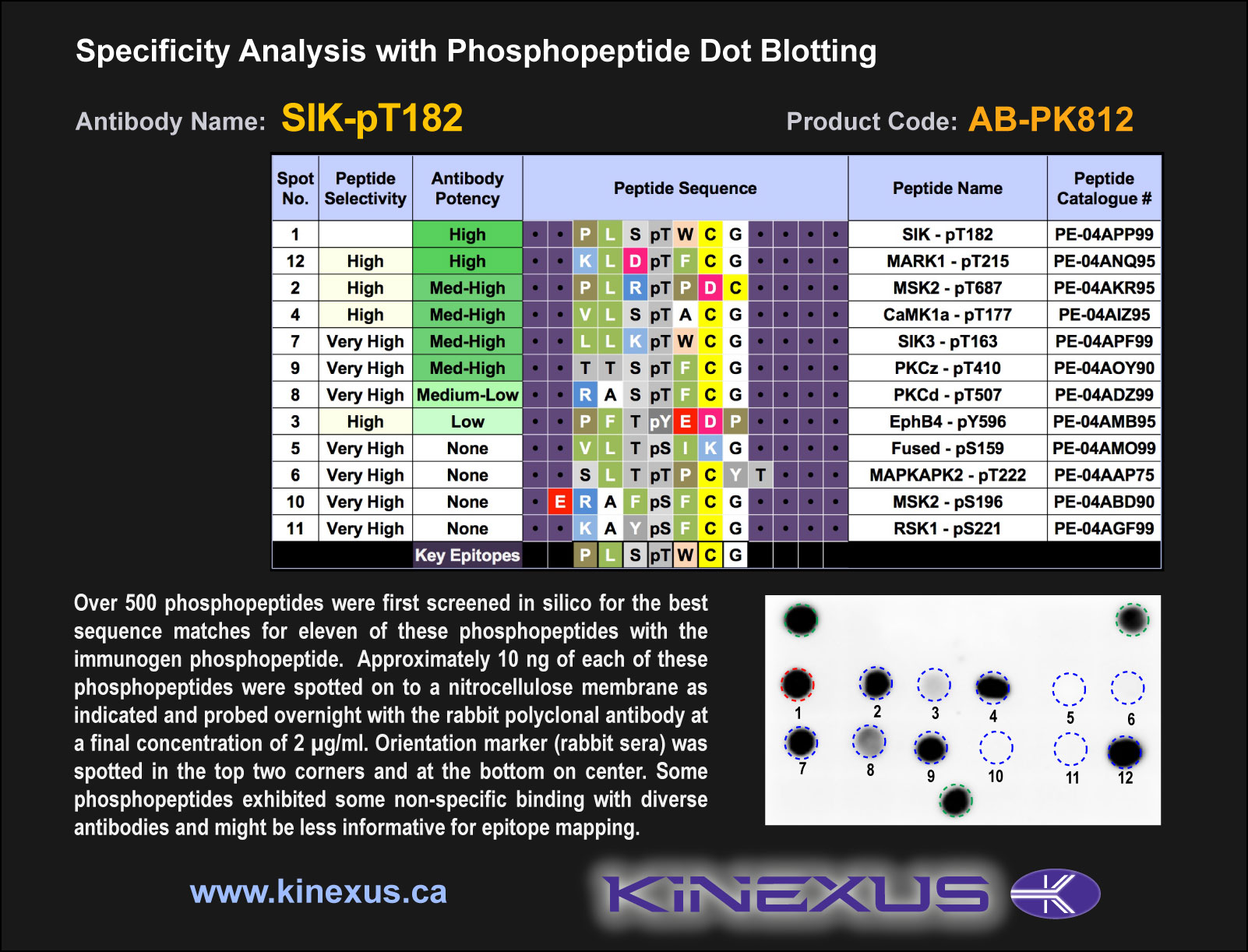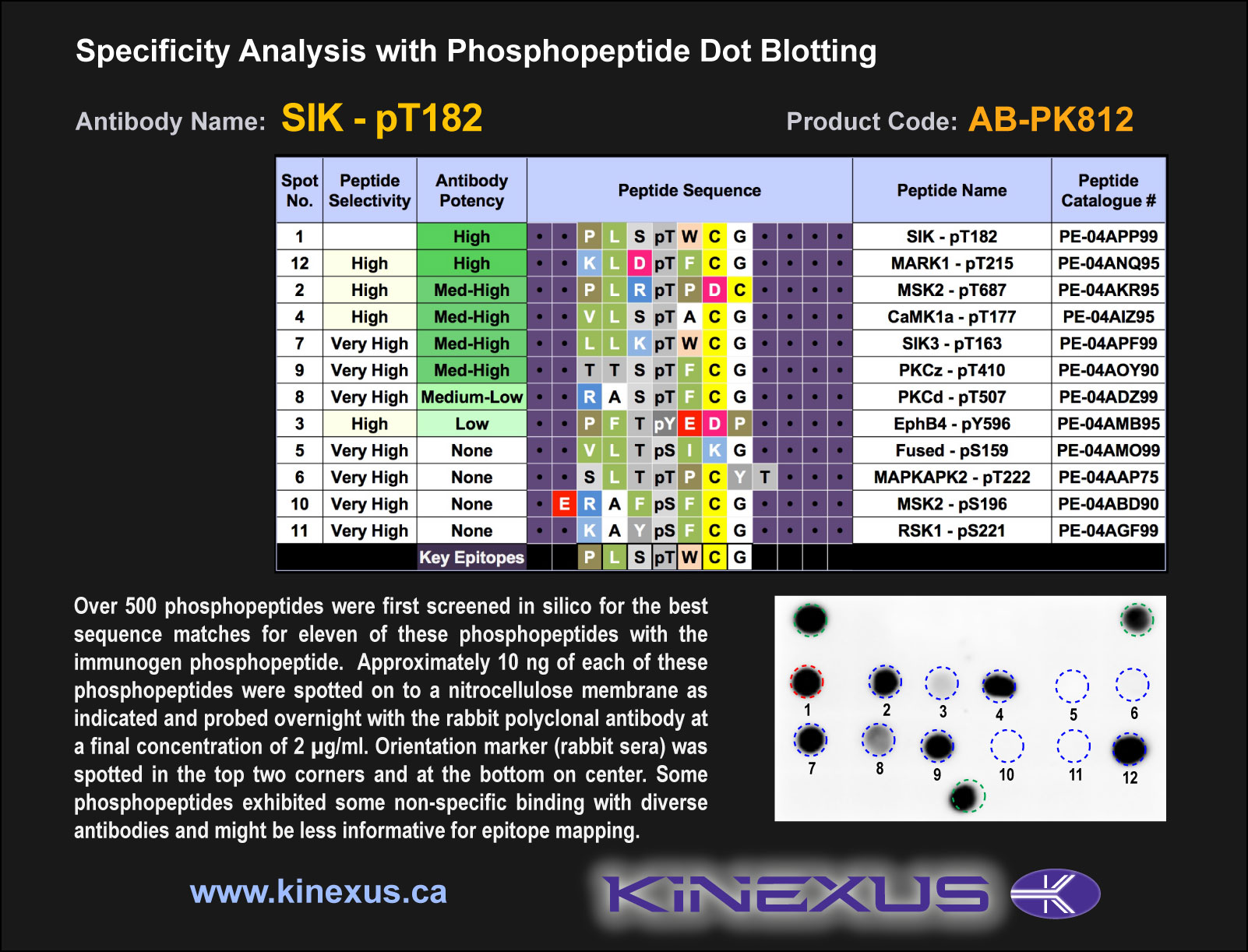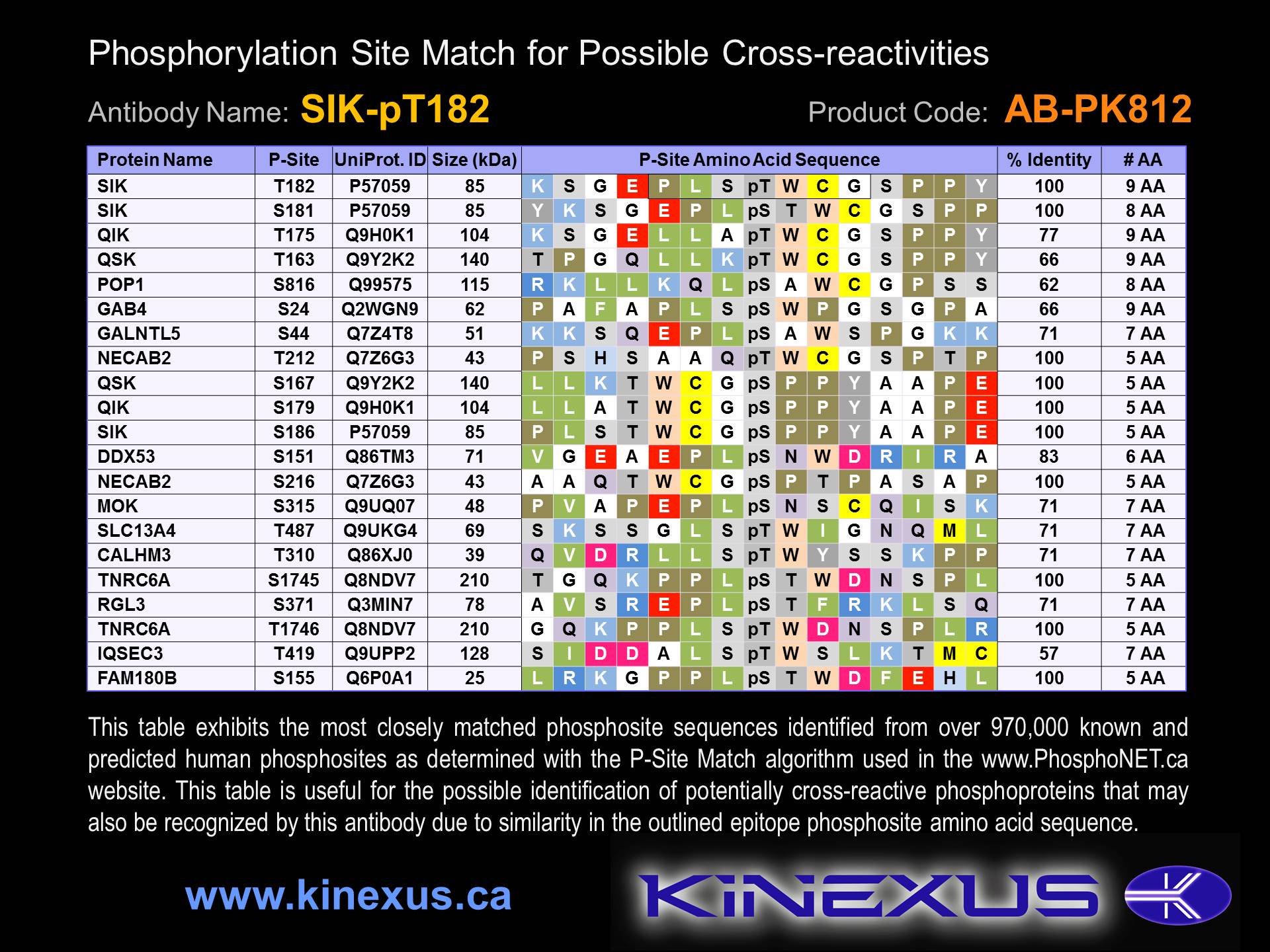Product Name: SIK-pT182
Product Number: AB-PK812
| Size: | 25 µg | Price: | 89.00 | |
| $US |
Target Full Name: Salt-inducible serine/threonine-protein kinase SIK1; Serine-threonine-protein kinase SNF1-like kinase 1
Target Alias: Msk; Myocardial SNF1-like kinase; Salt-inducible kinase; Salt-inducible kinase 1; Serine/threonine-protein kinase SNF1-like kinase 1; Serine/threonine-protein kinase SNF1LK; SIK1; SN1L1; SNF1-like kinase; SNF1LK
Product Type Specific: Protein kinase phosphosite-specific antibody
Antibody Code: PK812
Antibody Target Type: Phosphosite-specific
Antibody Phosphosite: T182
Protein UniProt: P57059
Protein SigNET: P57059
Antibody Type: Polyclonal
Target Alias: Msk; Myocardial SNF1-like kinase; Salt-inducible kinase; Salt-inducible kinase 1; Serine/threonine-protein kinase SNF1-like kinase 1; Serine/threonine-protein kinase SNF1LK; SIK1; SN1L1; SNF1-like kinase; SNF1LK
Product Type Specific: Protein kinase phosphosite-specific antibody
Antibody Code: PK812
Antibody Target Type: Phosphosite-specific
Antibody Phosphosite: T182
Protein UniProt: P57059
Protein SigNET: P57059
Antibody Type: Polyclonal
Antibody Host Species: Rabbit
Antibody Immunogen Source: Human SIK (SNF1LK) sequence peptide Cat. No.: PE-04APP99
Antibody Immunogen Sequence: PLS(pT)WCG(bA)C
Antibody Immunogen Description: Corresponds to amino acid residues P179 to G185; In the protein kinase catalytic domain activation T loop region between subdomains VII and VIII.
Antibody Immunogen Source: Human SIK (SNF1LK) sequence peptide Cat. No.: PE-04APP99
Antibody Immunogen Sequence: PLS(pT)WCG(bA)C
Antibody Immunogen Description: Corresponds to amino acid residues P179 to G185; In the protein kinase catalytic domain activation T loop region between subdomains VII and VIII.
Production Method: The immunizing peptide was produced by solid phase synthesis on a multipep peptide synthesizer and purified by reverse-phase hplc chromatography. Purity was assessed by analytical hplc and the amino acid sequence confirmed by mass spectrometry analysis. This peptide was coupled to KLH prior to immunization into rabbits. New Zealand White rabbits were subcutaneously injected with KLH-coupled immunizing peptide every 4 weeks for 4 months. The sera from these animals was applied onto an agarose column to which the immunogen peptide was thio-linked. Antibody was eluted from the column with 0.1 M glycine, pH 2.5. Subsequently, the antibody solution was neutralized to pH 7.0 with saturated Tris.This antibody was also subject to negative purification over phosphotyrosine-agarose.
Antibody Modification: Unconjugated. Contact KInexus if you are interest in having the antibody biotinylated or coupled with fluorescent dyes.
Antibody Modification: Unconjugated. Contact KInexus if you are interest in having the antibody biotinylated or coupled with fluorescent dyes.
Antibody Concentration: 1 mg/ml
Storage Buffer: Phosphate buffered saline pH 7.4, 0.05% Thimerasol
Storage Conditions: For long term storage, keep frozen at -40°C or lower. Stock solution can be kept at +4°C for more than 3 months. Avoid repeated freeze-thaw cycles.
Product Use: Western blotting | Antibody microarray
Antibody Dilution Recommended: 2 µg/ml for immunoblotting
Antibody Potency: Strong immunoreactivity with immunogen peptide on dot blots.
Antibody Species Reactivity: Human
Antibody Positive Control: The observed molecular mass of the processed target protein on SDS-PAGE gels is reported to be around 80-85 kDa.
Storage Buffer: Phosphate buffered saline pH 7.4, 0.05% Thimerasol
Storage Conditions: For long term storage, keep frozen at -40°C or lower. Stock solution can be kept at +4°C for more than 3 months. Avoid repeated freeze-thaw cycles.
Product Use: Western blotting | Antibody microarray
Antibody Dilution Recommended: 2 µg/ml for immunoblotting
Antibody Potency: Strong immunoreactivity with immunogen peptide on dot blots.
Antibody Species Reactivity: Human
Antibody Positive Control: The observed molecular mass of the processed target protein on SDS-PAGE gels is reported to be around 80-85 kDa.
Antibody Specificity: High-very high
Antibody Cross Reactivity: Only significant cross-reactivity with a 36 kDa protein in Jurkat cells.
Related Product 1: SIK-pT182 blocking peptide
Related Product 2: SIK-1 pan-specific antibody (Cat. No.: AB-NK251-1)
Related Product 3: SIK-2 pan-specific antibody (Cat. No.: AB-NK251-2)
Related Product 4: SIK-3 pan-specific antibody (Cat. No.: AB-NK251-3)
Related Product 5: AMPK/SIK KinSub - AMPK/SIK peptide substrate AMARAASAAALARRR
Antibody Cross Reactivity: Only significant cross-reactivity with a 36 kDa protein in Jurkat cells.
Related Product 1: SIK-pT182 blocking peptide
Related Product 2: SIK-1 pan-specific antibody (Cat. No.: AB-NK251-1)
Related Product 3: SIK-2 pan-specific antibody (Cat. No.: AB-NK251-2)
Related Product 4: SIK-3 pan-specific antibody (Cat. No.: AB-NK251-3)
Related Product 5: AMPK/SIK KinSub - AMPK/SIK peptide substrate AMARAASAAALARRR
Scientific Background: SIK (SNF1LK) is a protein-serine/threonine kinase of the CAMK group and CAMKL family. It can mediate gluconeogenesis, lipogenesis, cell cycle regulation, muscle differentiation, muscle growth, and tumour suppression. Substrates of SIK can include SREBF1, HDAC5, PPME1, TORC1/CRTC1, HDAC4, and TORC2/CRTC2. Phosphorylation at S186 increases phosphotransferase activity and induces interaction with 14-3-3. It is also activated by phosphorylation on T182 by STK11 in complex with STE20-related adapter-alpha (STRAD alpha) pseudo kinase and CAB39. SIK may be a tumour requiring protein (TRP). The loss of SIK1 has been correlated with poor prognosis for individuals suffering from breast cancer. Kinase phosphotransferase activity can be decreased without affecting autophosphorylation levels of SIK through either a S135A, or a S209A, or a S248A mutation. LKB1/LKB1-mediated phosphorylation and activation of SIK can be inhibited through a T182A mutation in SIK. Partial inhibition of phosphorylation and of kinase phosphotransferase activity has been observed with the S186A/D/C/G mutation. Abrogation of autophosphorylation and kinase phosphotransferase activity can occur with a S186T mutation.
Figure 1. Dot blotting SIK-pT182 antibody with recombinant purified proteins.
Figure 2. Epitope mapping of SIK-pT182 antibody with similar phosphopeptides on dot blots.
Figure 3. Epitope mapping of SIK-pT182 antibody with similar phosphopeptides on dot blots.
Figure 4. Identification of phosphosites related to SIK-pT182.
© Kinexus Bioinformatics Corporation 2017





